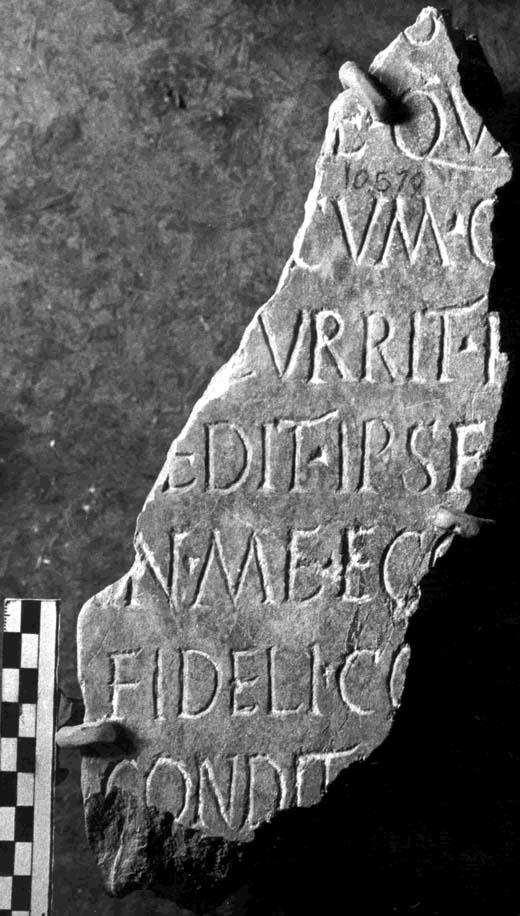Funerary carmen
Reference CIL II2/ 7, 564 | Description | Lyrics | Location | Chronology | Epigraphic edition | Translation | Apparatus | Comentary | Type of verse | Text divided into verses and metric signs | Images | Bibliography | Link to DB | Author |
Funerary carmen
Description
- Idno filename 22/01/0072
- Type of inscription: Sepulcralis
- Support: Tablet
- Material: Marble Material Description: Purplish marble limestone.
- Conservation status: Almost completely broken except for a piece of the left side.
- Dimensions height/width/depth (cm): 27.5/9/7.5
-
Epigraphic field:
- Layout: Triangular interpunctions.
- Epigraphic field execution: Back of stone roughly polished. Remains of guidelines.
- Preserved
Lyrics
- Font:Libraria
- Description of the letters:Capital book script, well executed, finished off with triangles. Horizontal crossbar of <T> lengthened and curving upwards. First stroke of the <E>, beginning from below, also curving upwards towards the end of the stroke. The <Q> has a long horizontal tail. In l. 2 remains of the left foot of an A; l. 3 remains of the curve of a letter, which could be C, Q or G; l. 4 remains of F or H; l. 8 remains of the upper part of a vertical stroke, perhaps an I.
Location
- Place of discovery: Found in 1950 in El Camino Viejo of Almodóvar, between Calle Siete de Mayo and Calle J. M. Herrero, in an excavation carried out by SANTOS GENER.
- Geolocation
- Conservation location: onserved in the MAP in Córdoba.
- Inventory number: 10522
- Location with Modern Nomenclature España / Córdoba / Almodóvar del Río
- Location with Old Nomenclature Hispania / Baetica / Cordubensis / Corduba
Chronology
- Inscription's dating: Between year 30 and year 70
Type of verse
- Verse/line correspondence: Si
- Prose/verse distinction: No
Epigraphic edition
‑ ‑ ‑ ‑ ‑ ‑
[‑ ‑ ‑] s[‑ ‑ ‑]
[‑ ‑ ‑]e ▴ qua[‑ ‑ ‑]
[‑ ‑ ‑] cum ▴ +[‑ ‑ ‑]
5 [‑ ‑ ‑]currit ▴ +[‑ ‑ ‑]
[d]edit ▴ ipse [‑ ‑ ‑]
in ▴ me▴ ego [‑ ‑ ‑]
fideli ▴ cọ[‑ ‑ ‑]
condit+[‑ ‑ ‑]
10 ‑ ‑ ‑ ‑ ‑ ‑
Bibliography
Santos Gener 1950, 211 n. 8 et 1955, 31; Stylow, II2/7, 564 cum im. phot.; Cugusi 2012, 166 – Cf. Hernández Pérez 2001a, 121 et 293; Carande 2010, 234.
Apparatus
4 currit · f[ ] Stylow.
Comentary
Funerary carmen, although we do not know how many lines are preserved, and
how many have been lost. Dactylic rhythm. The text conserved does not enable us to
determine whether it was in hexameters or elegiac distichs. Epigraphical topoi: currit
could refer to the fleeting nature of time (Currit enim ferox aetas Hor. Carm. 2,5,13). It
is also reminiscent of the sequence currere fatis found in Martín-Valls 1971, Verg. Aen.
12,149 and Ou. Am. 3,12,3. Fideli forms part of the elogium of the deceased. Conditi
may allude to the place of burial. Condere frequently appears in this type of
composition to describe the act of depositing the remains in the place chosen for their
repose.
Author
- Author:M. Limón Belén
- Last Update2024-02-25 16:58:55
- Autopsy date:2010
You can download this





